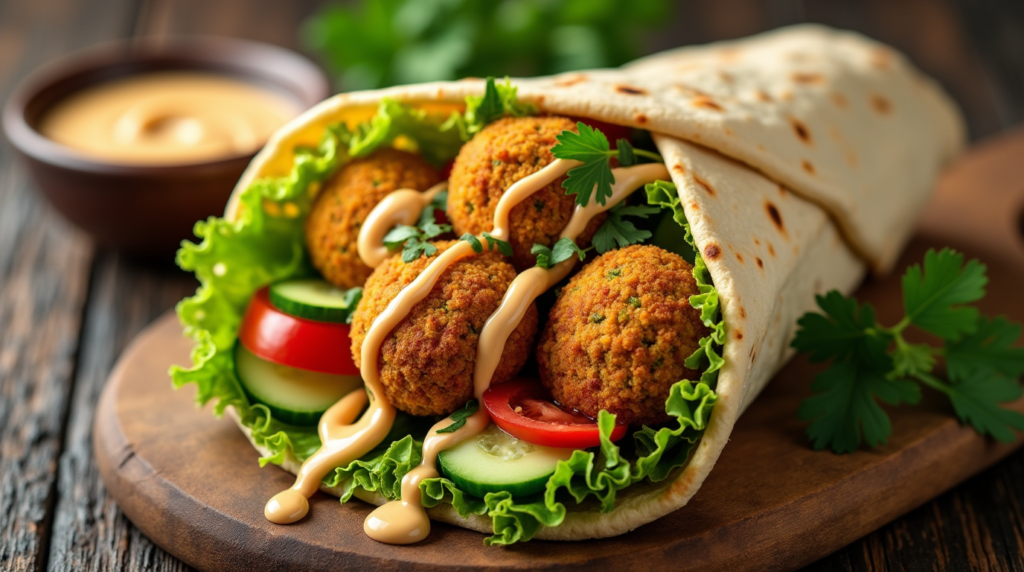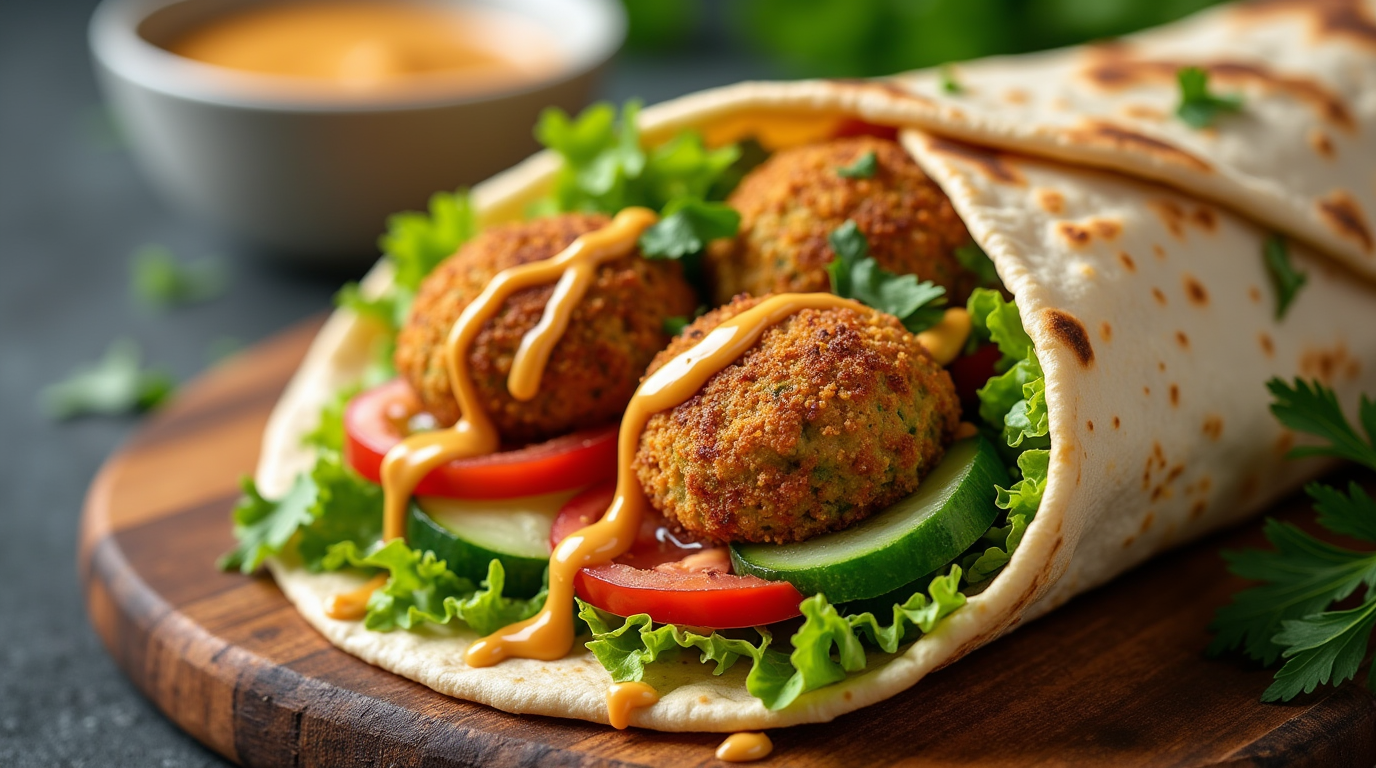Falafel Wraps: Your New Go-To Meal for Busy Days
A falafel wrap is not just a meal—it’s a celebration of flavor and texture, wrapped up in a neat, portable package. Whether you’ve enjoyed one at a bustling street food market or prepared it yourself at home, falafel wraps offer an irresistible combination of crispy falafel, fresh veggies, and rich, creamy sauces, all tucked into a soft, warm wrap. But what makes the perfect falafel wrap? Let’s explore how you can make your own at home, step by step.
What is a Falafel Wrap?
Before diving into the details of crafting the perfect falafel wrap, let’s break down what it actually is. A falafel wrap typically consists of crispy falafel balls, wrapped in soft pita or flatbread, and topped with fresh vegetables, sauces, and other tasty ingredients. The key to a great falafel wrap lies in the balance of flavors and textures—from the crunchy falafel to the cool, crisp vegetables and the creamy sauce.
Originating in the Middle East, falafel has become a beloved dish worldwide. Whether you’re enjoying it for lunch, dinner, or as a snack, it offers a quick yet satisfying meal that’s perfect for any occasion. Today, falafel wraps have evolved, incorporating different toppings and sauces, making them a versatile option to suit every taste.
The Key Ingredients for the Best Falafel Wrap

To create a truly irresistible falafel wrap, you’ll need the right ingredients. Let’s break them down:
The Perfect Falafel Balls
The heart of any falafel wrap is the falafel itself. These crispy, golden-brown balls are made from chickpeas (or fava beans) and seasoned with garlic, onion, parsley, and a variety of spices. To make falafel that’s crisp on the outside yet light and tender on the inside, here’s what you’ll need:
- Chickpeas (soaked overnight)
- Garlic and onion (for flavor)
- Fresh herbs like parsley and cilantro
- Spices including cumin, coriander, and cayenne pepper
- Flour (for binding) and baking powder (to help them puff up)
The texture of your falafel balls is crucial. Overmixing can result in a dense texture, while undermixing will make them fall apart during frying. Soaking your chickpeas rather than using canned ones is essential for achieving that perfect consistency.
Fresh and Flavorful Wrap Ingredients
- Bread: The most common options are pita or flatbread. Pita, with its pocket, is ideal for stuffing with your falafel and toppings. Flatbreads, on the other hand, offer a sturdier option for wrapping.
- Fresh Vegetables: Crisp veggies like tomatoes, cucumbers, lettuce, and red onions bring a refreshing crunch to your wrap.
- Sauces: The right sauce can make all the difference. Tahini, hummus, tzatziki, or a spicy yogurt dressing complement the falafel perfectly. You can also try adding hot sauce or a drizzle of olive oil for added flavor.
- Optional Add-ins: Pickled vegetables or olives add a tangy contrast to the other ingredients. A little extra richness can be achieved with cheese or avocado.
Step-by-Step Guide to Making the Perfect Falafel Wrap
Now that you have all the ingredients, let’s walk through the process of making the perfect falafel wrap.
Step 1: Prepare the Falafel Mixture
- Soak the Chickpeas: Begin by soaking your dried chickpeas overnight. This step is essential for the right texture. Canned chickpeas will not work as well because they’re too soft.
- Blend the Ingredients: Once the chickpeas are soaked, blend them with garlic, onion, parsley, cilantro, and spices. The mixture should be coarse, not smooth, to maintain texture. Add flour and baking powder to help the falafel hold its shape.
- Chill the Mixture: Let the falafel mixture chill in the fridge for about 30 minutes. This will make it easier to shape the falafel balls and prevent them from falling apart during frying.
Step 2: Shape and Fry the Falafel
- Shape the Falafel: Once the mixture has chilled, use your hands or a spoon to form small balls or patties. Make sure they’re uniform in size for even cooking.
- Fry the Falafel: Heat oil in a deep pan to around 350°F (175°C). Fry the falafel in batches, ensuring they have plenty of space in the oil. Fry until golden brown and crispy, about 3-4 minutes per side.
Step 3: Assemble the Wrap
- Warm the Bread: Heat your pita or flatbread in a skillet or microwave for a few seconds to make it more pliable.
- Layer the Ingredients: Start by spreading a generous amount of your chosen sauce on the wrap. Then, add a few falafel balls, followed by your fresh veggies. You can add extras like pickles or olives for an extra punch of flavor.
- Wrap it Up: Carefully fold the sides of the bread and roll it tightly to enclose the filling.
Health Benefits of a Falafel Wrap
A falafel wrap is not just delicious; it’s also packed with nutrients. Here’s why it’s a great choice for a balanced meal:
- Plant-Based Protein: Falafel is made from chickpeas, a fantastic source of plant-based protein. This makes it an excellent option for vegetarians, vegans, or anyone looking to reduce meat consumption.
- Rich in Fiber: Chickpeas are high in fiber, which helps with digestion and keeps you feeling full longer.
- Healthy Fats: Adding tahini, avocado, or olive oil provides healthy fats that are essential for your body’s function.
- Packed with Vegetables: Fresh veggies in your wrap add vitamins, minerals, and antioxidants, making it a wholesome meal.
Common Mistakes to Avoid When Making Falafel Wraps
To make sure your falafel wrap turns out perfectly every time, here are some common mistakes to avoid:
- Using Canned Chickpeas: Always soak dried chickpeas overnight for the best texture. Canned chickpeas are too soft and will result in a mushy falafel.
- Overmixing the Mixture: If you blend the ingredients too much, your falafel will be dense. Aim for a coarse mixture for light, fluffy falafel.
- Frying at the Wrong Temperature: If the oil is too hot, your falafel will burn on the outside while staying raw inside. If it’s too cold, they’ll be soggy. Aim for 350°F (175°C).
- Underseasoning: Falafel needs a good amount of seasoning to bring out its flavors. Be generous with your spices, and don’t forget salt and pepper!
Falafel Wrap Variations Around the World
One of the great things about falafel wraps is how versatile they are. Depending on where you are or what you’re craving, you can easily switch things up:
- Classic Middle Eastern Style: The traditional falafel wrap often includes tahini, fresh herbs, and a variety of fresh vegetables.
- Greek Influence: Add tzatziki and feta cheese for a Mediterranean twist on the falafel wrap.
- Vegan Falafel Wrap: Skip the cheese and add more veggies, avocado, or a dairy-free sauce like hummus or vegan tzatziki.
- Spicy Falafel Wrap: Add spicy chili sauce or harissa to give your wrap an extra kick.
Nutritional Facts for the Perfect Falafel Wrap
Here’s a quick look at the nutritional breakdown of your typical falafel wrap:
| Ingredient | Calories (per serving) | Carbs | Protein | Fat |
|---|---|---|---|---|
| Falafel (per ball) | 100 | 18g | 5g | 4g |
| Pita Bread | 170 | 35g | 6g | 1.5g |
| Toppings (vegetables) | 50 | 12g | 1g | 0.5g |
| Tahini Sauce | 150 | 6g | 4g | 12g |
Frequently Asked Questions (FAQ) About Falafel Wraps
- Can I make falafel wraps ahead of time?
- Yes, you can prepare the falafel and toppings in advance. Store them separately and assemble the wrap when you’re ready to eat.
- What can I substitute if I don’t have tahini for the sauce?
- You can use hummus, Greek yogurt, or avocado as alternatives.
- How can I make my falafel wrap gluten-free?
- Use gluten-free wraps and ensure your falafel mixture does not contain wheat flour.
- Can I freeze falafel balls for later use?
- Absolutely! You can freeze cooked or uncooked falafel balls in an airtight container.
- What are the best toppings for a falafel wrap?
- Fresh veggies, pickles, tahini sauce, and spicy chili sauce are all great choices.
Conclusion
A falafel wrap is a perfect blend of crispy falafel, fresh veggies, and flavorful sauces—all wrapped in a soft pita or flatbread. By following the tips and steps outlined in this guide, you can make the perfect falafel wrap at home, packed with protein, fiber, and flavor. Whether you’re looking for a plant-based meal, a quick lunch, or just a fun way to enjoy Middle Eastern cuisine, the falafel wrap is the way to go. So why not try making your own today? Your taste buds will thank you!

